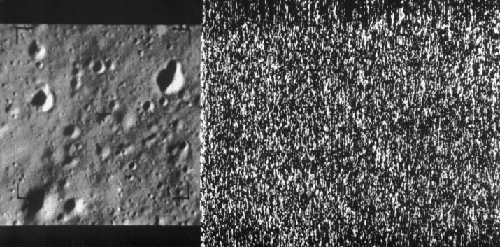The Ranger program of unmanned lunar probes (1961 to 1965) used a mission design that has seldom been followed — at least intentionally. Ranger was a hard-lander: The spacecraft flew to the Moon, turned six TV cameras on about 20 minutes before reaching it, and kept them running as the spacecraft flew straight into the ground.
The goal of the program was to take high-resolution photos of the lunar maria to determine its roughness for the manned Apollo landing flights to come. But Project Ranger achieved a terrible track record. Rangers 1 and 2 failed to leave Earth orbit, and Rangers 3 through 6 all failed on the way to the Moon. These failures caused the Jet Propulsion Laboratory (JPL), Ranger’s builder, enormous public difficulties and expense. What seemed like an endless string of mishaps led the U. S. Congress to demand — and get — an investigation.
Finally Rangers 7 and 8 flew successfully and carried out the program’s basic mission. Ranger 9’s targeting was then left to scientists. They chose the interior of Alphonsus Crater, about 60 miles (100 kilometers) in diameter and familiar to every backyard Moon-watcher. At the time, the crater’s central peak was suspected of emitting volcanic gases. Besides the central peak, scientists hoped the spacecraft would also get a good look at the lunar highlands adjacent to the crater.
Ranger 9 was launched March 21, 1965, and on the 24th, it hit the Moon at 14h 08m 20s Universal Time. It was traveling at 1.7 miles (2.7 km) per second. In a Space Age first, the images from the Ranger’s cameras were broadcast live on nationwide TV.
The video starts with a view of the Moon that’s worse than the average backyard telescope shows. But the scene improves as the spacecraft follows its collision course with the floor of Alphonsus. The last view, snatched from a few hundred yards’ altitude, shows craters only a dozen yards across. To get a better view, you’d have to go there yourself.
In his superb history of lunar science, To a Rocky Moon, Don Wilhelms wrote of the Ranger program, “The Rangers provided a new perspective on the old problem of crater origin and marked, I think, a decisive shift by the fence-straddlers over to the impact side.”
Wilhelms also notes, however, that Ranger’s design kept it from achieving very much. As its images showed ever-finer details, they also covered less and less surface.
By the end of Project Ranger in the spring of 1965, another program was fast developing — Lunar Orbiter. This was a series of five orbital spacecraft that surveyed almost all the Moon in great detail and provided a basis for understanding lunar geological history.
Better missions were in the pipeline, says Wilhelms. “You simply needed to see more of the Moon — much, much more — than three or three dozen Rangers could show.”










